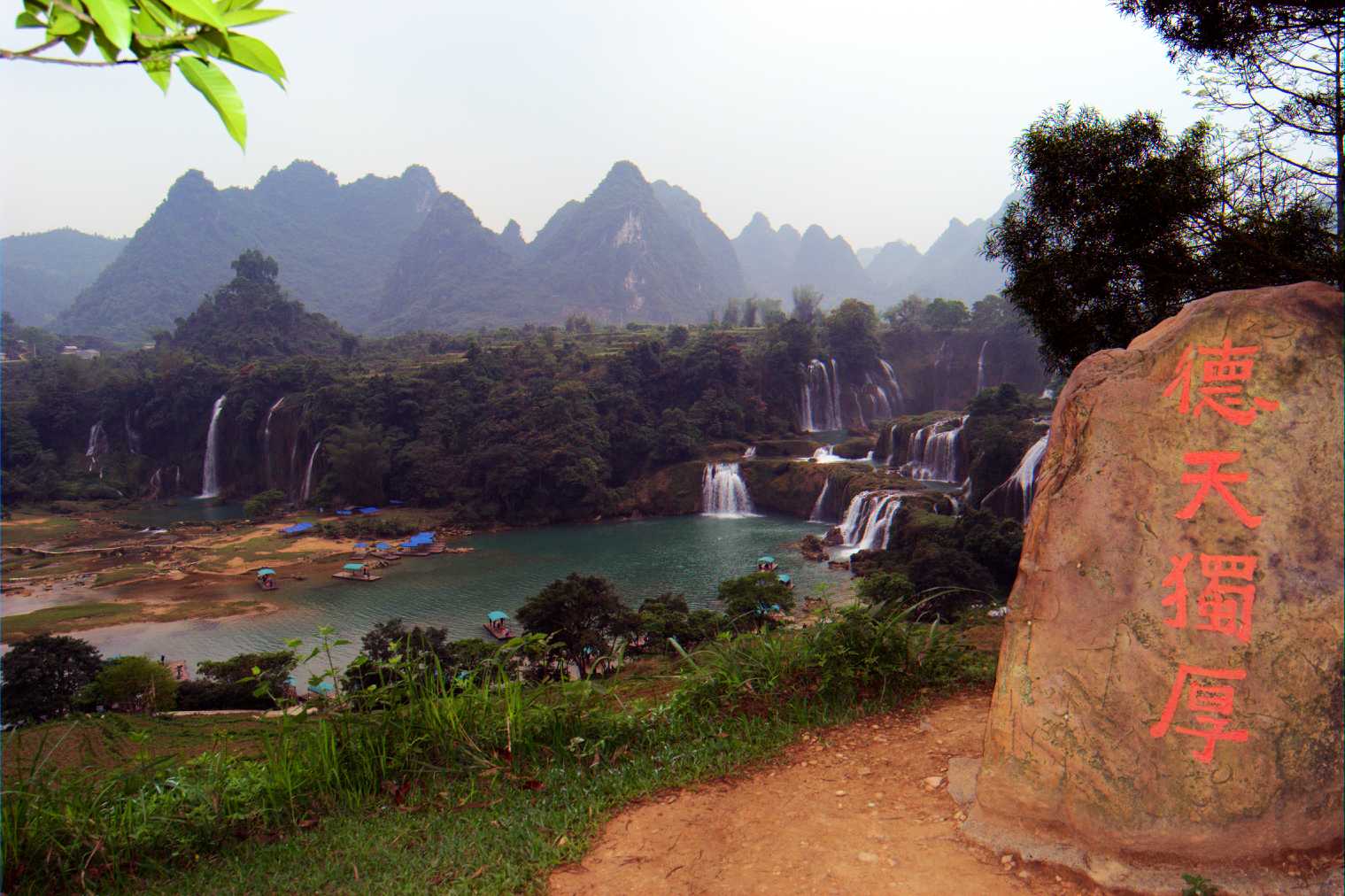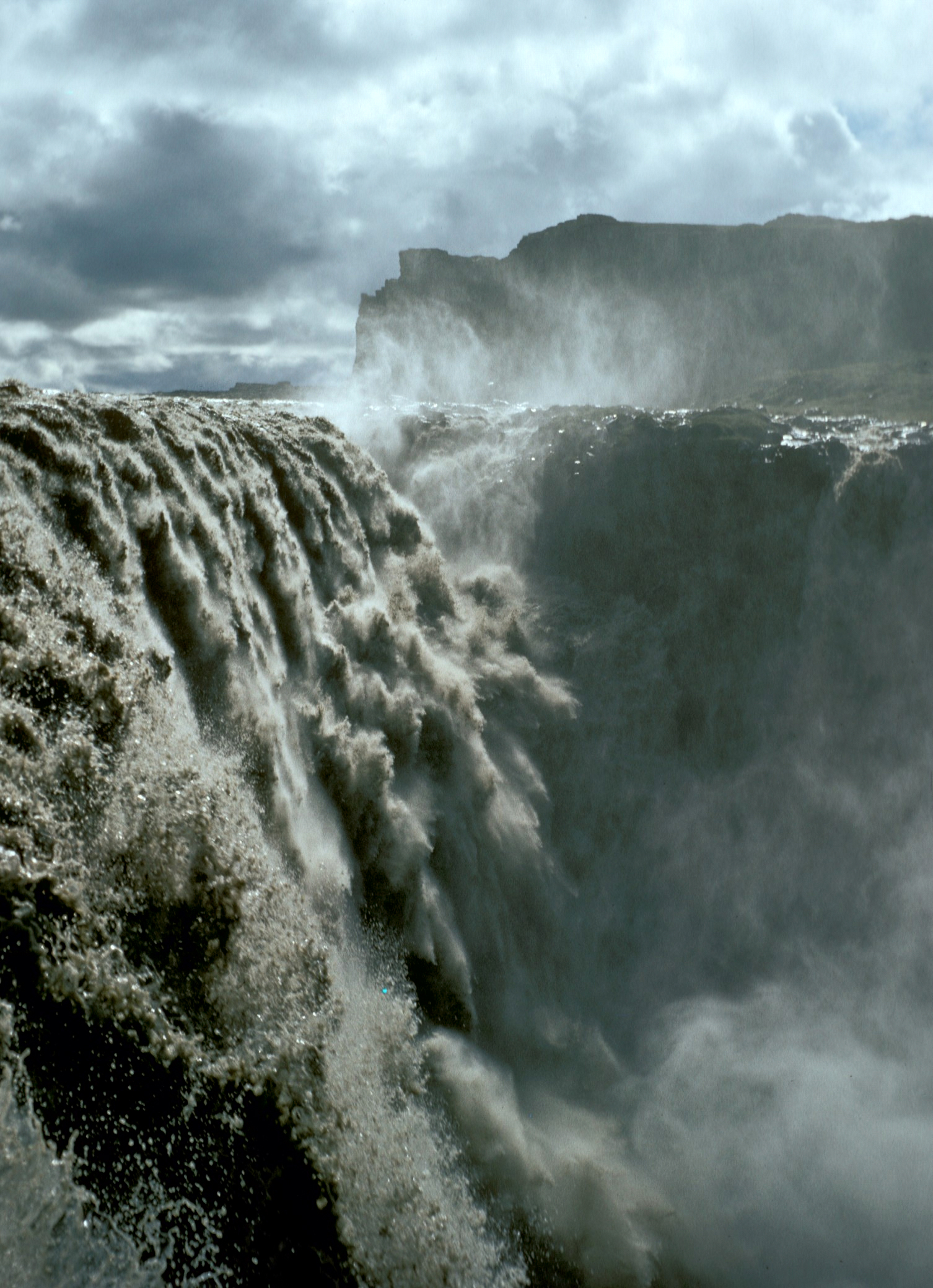|
Ban Gioc–Detian Falls
Bản Giốc – Detian Falls or Bản Giốc Falls is a collective name for two waterfalls on the Quây Sơn River (Vietnamese: Sông Quây Sơn, chữ Nôm: 滝𡇸山; Chinese: 归春河, Pinyin: Guīchūn hé) that straddle the international border between China and Vietnam; more specifically located between the Karst hills of Daxin County, Guangxi and Trùng Khánh District, Cao Bằng Province. The waterfalls are located north of Hanoi. Characteristics Over thousands of years, the waterfall has eroded its crest and slowly moved upstream. It currently appears to be two waterfalls most of the time, but when the river is swollen due to summer rains can form one fall again. In Vietnamese, the two falls are considered as two parts of one waterfall with the sole name Bản Giốc. The two parts are thác chính (Main waterfall) and thác phụ (Subordinate waterfall). Chinese texts sometimes name both of the water falls as Détiān Falls (Chinese: 德天瀑布) on the Chinese s ... [...More Info...] [...Related Items...] OR: [Wikipedia] [Google] [Baidu] |
Quây Sơn River
The Quây Sơn River ( vi, Sông Quây Sơn, Sông Quế Sơn; chữ Nôm: 滝𡇸山, 滝桂山) or as the Guichun River as it is known in China, (Chinese: 归春河, Pinyin: ) is a river that passes through Cao Bằng Province, Vietnam and Guangxi province, China. The river originates in China in Jingxi County in the Chongshan Mountain Range (Chinese:崇山峻岭, Pinyin Hanyu Pinyin (), often shortened to just pinyin, is the official romanization system for Standard Mandarin Chinese in China, and to some extent, in Singapore and Malaysia. It is often used to teach Mandarin, normally written in Chinese for ...: Chóngshān jùnlǐng).杨容义 ''广西: 美丽神奇的地方'' 广西壮族自治区人民政府新闻办公室 2006 Page 180 "德天瀑布的源头是归春河,归春河是左江的支流。从硕龙到德天瀑布,归春河十里蜿蜒相伴,在这里中越两国以河为界。归春河起源于广西靖西县的崇山峻岭,流向越南,在越南转了个� ... [...More Info...] [...Related Items...] OR: [Wikipedia] [Google] [Baidu] |
Karst
Karst is a topography formed from the dissolution of soluble rocks such as limestone, dolomite, and gypsum. It is characterized by underground drainage systems with sinkholes and caves. It has also been documented for more weathering-resistant rocks, such as quartzite, given the right conditions. Subterranean drainage may limit surface water, with few to no rivers or lakes. However, in regions where the dissolved bedrock is covered (perhaps by debris) or confined by one or more superimposed non-soluble rock strata, distinctive karst features may occur only at subsurface levels and can be totally missing above ground. The study of ''paleokarst'' (buried karst in the stratigraphic column) is important in petroleum geology because as much as 50% of the world's hydrocarbon reserves are hosted in carbonate rock, and much of this is found in porous karst systems. Etymology The English word ''karst'' was borrowed from German in the late 19th century, which entered German much earlier ... [...More Info...] [...Related Items...] OR: [Wikipedia] [Google] [Baidu] |
International Waterfalls
International is an adjective (also used as a noun) meaning "between nations". International may also refer to: Music Albums * ''International'' (Kevin Michael album), 2011 * ''International'' (New Order album), 2002 * ''International'' (The Three Degrees album), 1975 *''International'', 2018 album by L'Algérino Songs * The Internationale, the left-wing anthem * "International" (Chase & Status song), 2014 * "International", by Adventures in Stereo from ''Monomania'', 2000 * "International", by Brass Construction from ''Renegades'', 1984 * "International", by Thomas Leer from ''The Scale of Ten'', 1985 * "International", by Kevin Michael from ''International'' (Kevin Michael album), 2011 * "International", by McGuinness Flint from ''McGuinness Flint'', 1970 * "International", by Orchestral Manoeuvres in the Dark from '' Dazzle Ships'', 1983 * "International (Serious)", by Estelle from '' All of Me'', 2012 Politics * Political international, any transnational organization of ... [...More Info...] [...Related Items...] OR: [Wikipedia] [Google] [Baidu] |
Waterfalls Of China
This list of notable waterfalls of the world is sorted by continent, then country, then province, state or territory. A waterfall is included if it has an existing article specifically for it on Wikipedia, and it is at least high, or the falls have some historical significance based on multiple reliable references. There is no standard way to measure the height or width of a waterfall. No ranking of waterfalls should be assumed because of the heights or widths provided in the list. Many numbers are estimated and measurements may be imprecise. See additional lists of waterfalls by height, flow rate and type. Africa Angola * Kalandula Falls – high Burundi * Kagera Falls * Rusumo Falls Central African Republic * Boali Falls Chad * Gauthiot Falls Democratic Republic of the Congo * Boyoma Falls – formerly known as Stanley Falls; highest flow rate in the world * Inga Falls * Livingstone Falls * Lofoi Falls – high Ethiopia * Blue Nile Falls ... [...More Info...] [...Related Items...] OR: [Wikipedia] [Google] [Baidu] |
Waterfalls Of Vietnam
A waterfall is a point in a river or stream where water flows over a vertical drop or a series of steep drops. Waterfalls also occur where meltwater drops over the edge of a tabular iceberg or ice shelf. Waterfalls can be formed in several ways, but the most common method of formation is that a river courses over a top layer of resistant bedrock before falling on to softer rock, which erodes faster, leading to an increasingly high fall. Waterfalls have been studied for their impact on species living in and around them. Humans have had a distinct relationship with waterfalls for years, travelling to see them, exploring and naming them. They can present formidable barriers to navigation along rivers. Waterfalls are religious sites in many cultures. Since the 18th century they have received increased attention as tourist destinations, sources of hydropower, andparticularly since the mid-20th centuryas subjects of research. Definition and terminology A waterfall is generally ... [...More Info...] [...Related Items...] OR: [Wikipedia] [Google] [Baidu] |
Landforms Of Guangxi
A landform is a natural or anthropogenic land feature on the solid surface of the Earth or other planetary body. Landforms together make up a given terrain, and their arrangement in the landscape is known as topography. Landforms include hills, mountains, canyons, and valleys, as well as shoreline features such as bays, peninsulas, and seas, including submerged features such as mid-ocean ridges, volcanoes, and the great ocean basins. Physical characteristics Landforms are categorized by characteristic physical attributes such as elevation, slope, orientation, stratification, rock exposure and soil type. Gross physical features or landforms include intuitive elements such as berms, mounds, hills, ridges, cliffs, valleys, rivers, peninsulas, volcanoes, and numerous other structural and size-scaled (e.g. ponds vs. lakes, hills vs. mountains) elements including various kinds of inland and oceanic waterbodies and sub-surface features. Mountains, hills, plateaux, and plains are t ... [...More Info...] [...Related Items...] OR: [Wikipedia] [Google] [Baidu] |
Landforms Of Cao Bằng Province
A landform is a natural or anthropogenic land feature on the solid surface of the Earth or other planetary body. Landforms together make up a given terrain, and their arrangement in the landscape is known as topography. Landforms include hills, mountains, canyons, and valleys, as well as shoreline features such as bays, peninsulas, and seas, including submerged features such as mid-ocean ridges, volcanoes, and the great ocean basins. Physical characteristics Landforms are categorized by characteristic physical attributes such as elevation, slope, orientation, stratification, rock exposure and soil type. Gross physical features or landforms include intuitive elements such as berms, mounds, hills, ridges, cliffs, valleys, rivers, peninsulas, volcanoes, and numerous other structural and size-scaled (e.g. ponds vs. lakes, hills vs. mountains) elements including various kinds of inland and oceanic waterbodies and sub-surface features. Mountains, hills, plateaux, and plains are t ... [...More Info...] [...Related Items...] OR: [Wikipedia] [Google] [Baidu] |
Cape Cà Mau
Cape Cà Mau (''Mũi Cà Mau'') on Cà Mau Peninsula in Vietnam, is the southernmost point of the Vietnamese mainland. Gallery File:Tuongdaimuicamau.jpg, The ship-shaped monument marks the geographical location of Cape Ca Mau File:Mui Ca Mau 005.JPG, The cape at sunset File:Satellite picture of Ca Mau 2020-12-21-00 00 2020-12-21-23 59 Sentinel-2 L2A.jpg, Satellite view See also *Cape Ca Mau National Park A cape is a clothing accessory or a sleeveless outer garment which drapes the wearer's back, arms, and chest, and connects at the neck. History Capes were common in medieval Europe, especially when combined with a hood in the chaperon. Th ... References Landforms of Vietnam Landforms of Cà Mau province Headlands of Asia {{Vietnam-geo-stub ... [...More Info...] [...Related Items...] OR: [Wikipedia] [Google] [Baidu] |
Friendship Pass
Friendship Pass (), also commonly known by its older name Ải Nam Quan (), is a pass near the China-Vietnam border, between China's Guangxi and Vietnam's Lạng Sơn Province. The pass itself lies just inside the Chinese side of the border. Vietnamese National Route 1 starts at the border near this pass, which lies less than 5 km north of the town of Đồng Đăng in Lạng Sơn Province, ending in Năm Căn in Cà Mau Province. China National Highway 322 runs from here to Guangxi Province and Hunan Province. This is one of the busiest border trading points of Vietnam. It was built in the early Ming dynasty with the name of "South Suppressing Pass" (). In 1953, its name was changed to "South Harmonious Pass" (). In 1965, its name was changed again to the current Friendship Pass, reflecting the close political, military, and economic ties between the People's Republic of China and North Vietnam during the then-ongoing Vietnam War. History Traditionally, the pas ... [...More Info...] [...Related Items...] OR: [Wikipedia] [Google] [Baidu] |
Sino-Vietnamese War
The Sino-Vietnamese War (also known by #Names, other names) was a border war fought between China and Vietnam in early 1979. China launched an offensive in response to Vietnam's Cambodian–Vietnamese War, actions against the Khmer Rouge in 1978, which ended the rule of the Chinese-backed Khmer Rouge. Both China and Vietnam claimed victory in the last of the Indochina Wars. Chinese forces invaded northern Vietnam and captured several cities near the China-Vietnam border, border. On 6 March 1979, China declared that the gate to Hanoi was open and that their punitive mission had been achieved. Chinese troops then withdrew from Vietnam. As Vietnamese troops remained in Cambodia until 1989, China was unsuccessful in its goal of dissuading Vietnam from involvement in Cambodia. Following the dissolution of the Soviet Union in 1991, the Sino-Vietnamese border was finalized. Although unable to deter Vietnam from ousting Pol Pot from Cambodia, China demonstrated that its Cold War commu ... [...More Info...] [...Related Items...] OR: [Wikipedia] [Google] [Baidu] |
Qing Dynasty
The Qing dynasty ( ), officially the Great Qing,, was a Manchu-led imperial dynasty of China and the last orthodox dynasty in Chinese history. It emerged from the Later Jin dynasty founded by the Jianzhou Jurchens, a Tungusic-speaking ethnic group who unified other Jurchen tribes to form a new "Manchu" ethnic identity. The dynasty was officially proclaimed in 1636 in Manchuria (modern-day Northeast China and Outer Manchuria). It seized control of Beijing in 1644, then later expanded its rule over the whole of China proper and Taiwan, and finally expanded into Inner Asia. The dynasty lasted until 1912 when it was overthrown in the Xinhai Revolution. In orthodox Chinese historiography, the Qing dynasty was preceded by the Ming dynasty and succeeded by the Republic of China. The multiethnic Qing dynasty lasted for almost three centuries and assembled the territorial base for modern China. It was the largest imperial dynasty in the history of China and in 1790 the f ... [...More Info...] [...Related Items...] OR: [Wikipedia] [Google] [Baidu] |

.jpg)

.jpg)
